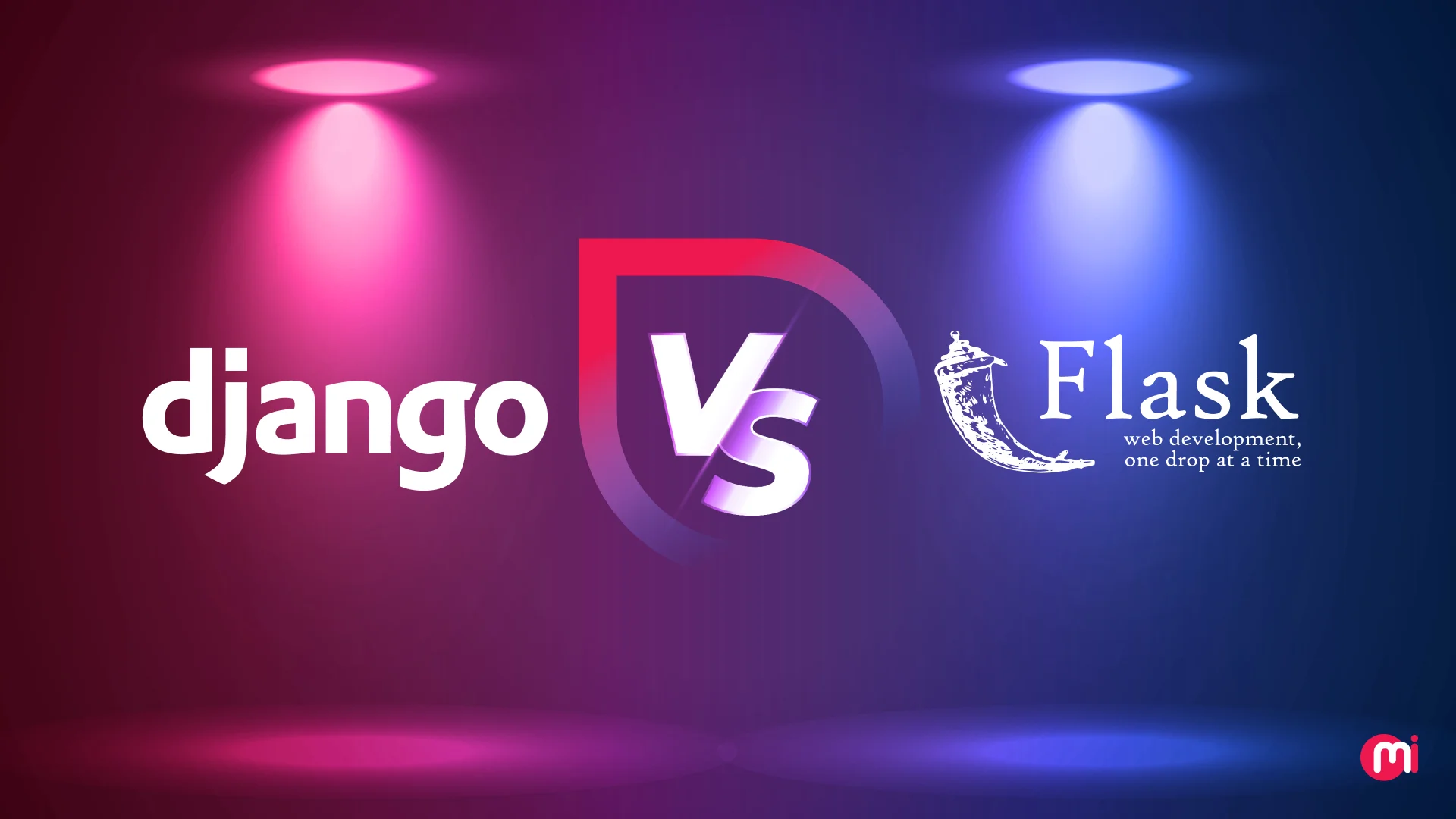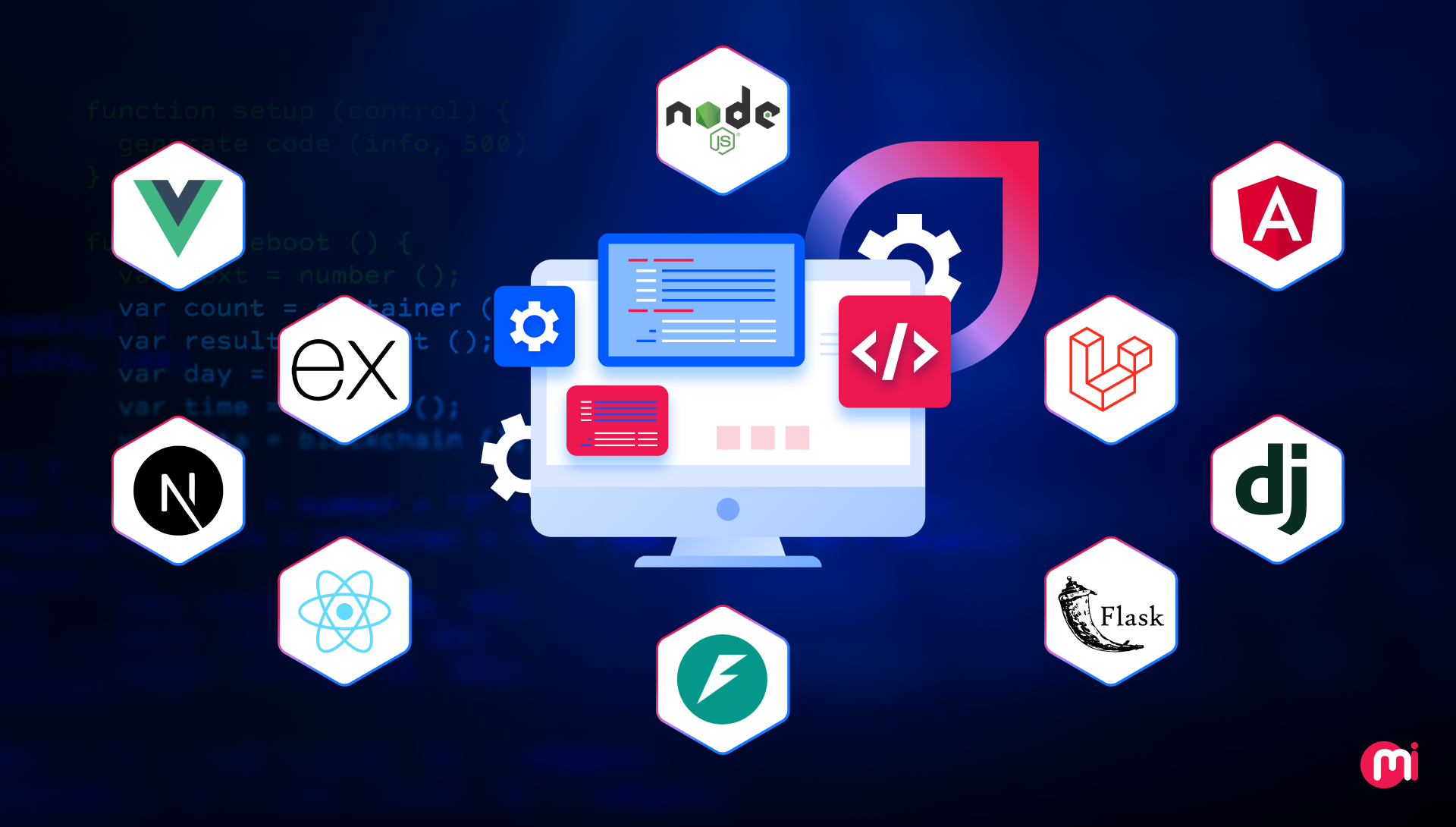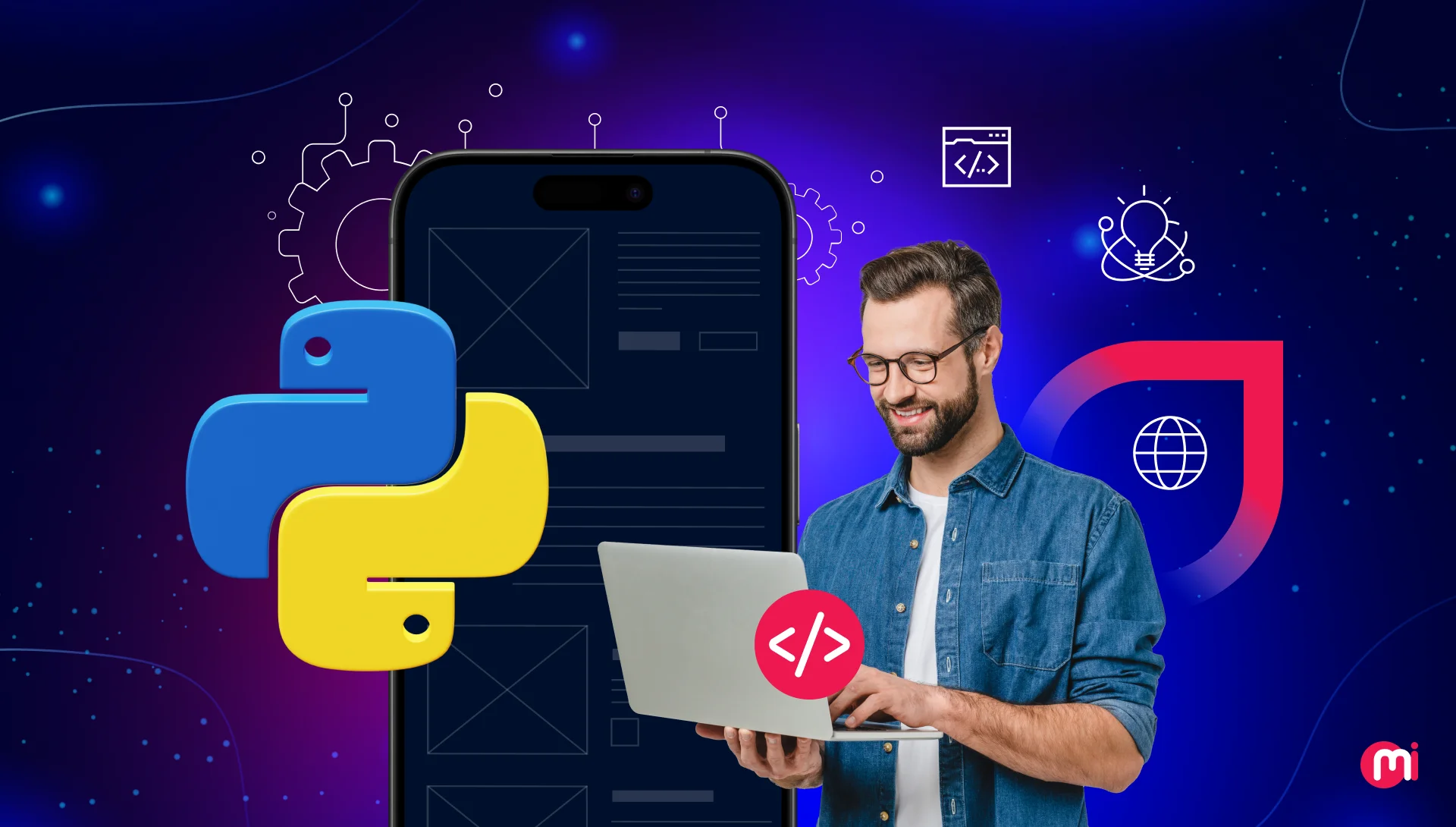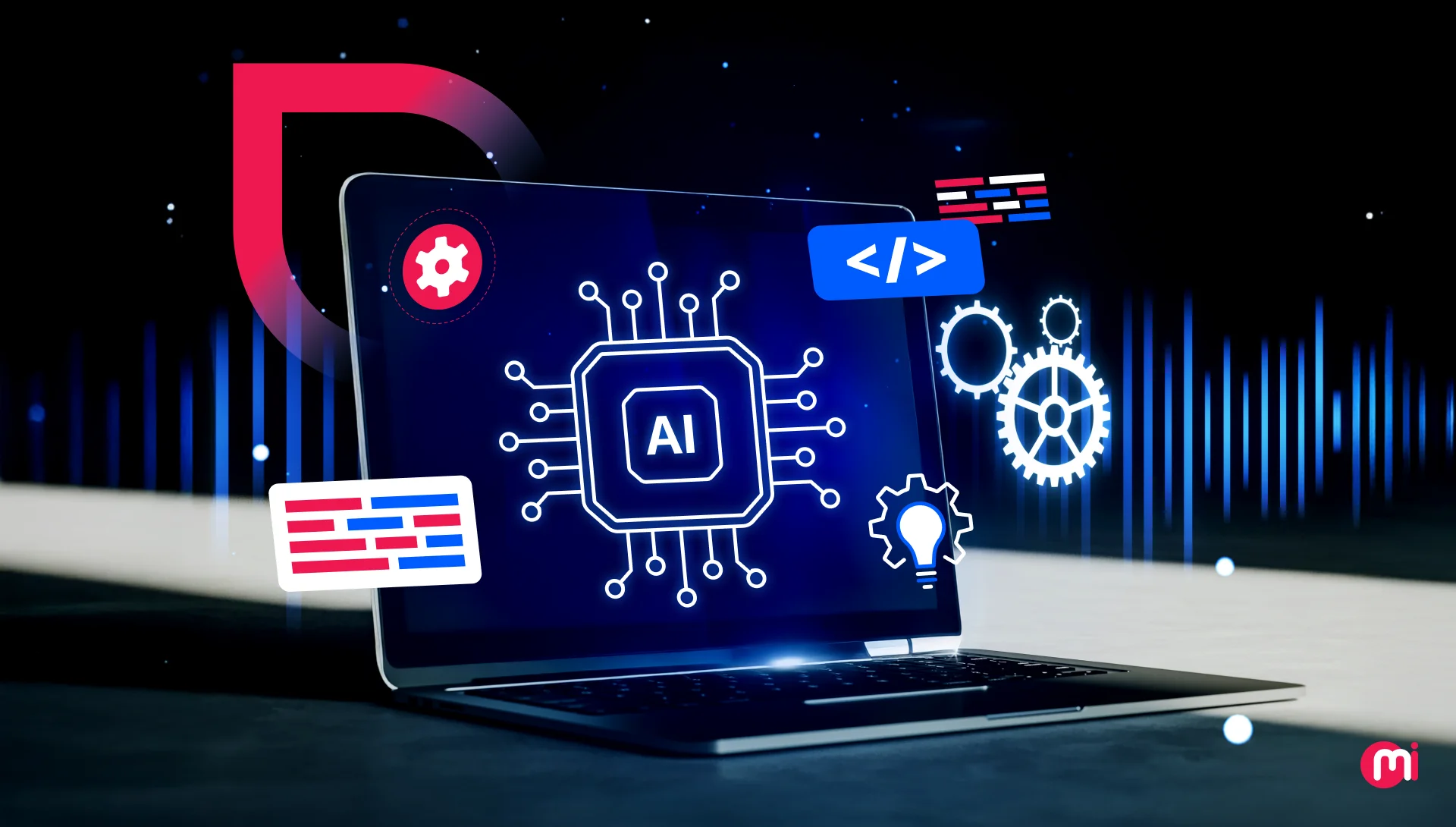Django vs Flask: Which Python Framework to Choose in 2025?
- Web
- June 27, 2025
Deciding between Django and Flask for your next project in 2025? This blog breaks down Django vs Flask, the two most popular Python web frameworks, to help you make a confident, future-ready decision. Whether you’re a startup founder, CTO, or product strategist at a mid-scale company or enterprise, you’ll get a clear comparison of their features, pros and cons, use cases, real-world examples of companies, and expert analysis to choose one.
In 2025, building scalable, fast, and secure web applications equipped with AI is more critical than ever. Python remains the go-to backend language for thousands of developers and startups, particularly for AI-led web development services. However, to leverage the full potential of this language and speed up the innovation, you must choose one of two leading frameworks: Django and Flask.
But here’s the catch: both are powerful in their own way. Hence, choosing the right one is not as straightforward as it seems. So, whether you are planning to develop an MVP, launch a new software product, or modernize your existing tech stack with Python, the right selection between Django and Flask can shape your project’s success.
In this detailed guide, we’ll break down the key features, pros and cons, use cases, performance, and real-world applications of both frameworks of Python for software development. By the end of this blog, you’ll be able to make an informed, strategic choice.
Not sure about Django or Flask? Our guide about top Python frameworks can also help you explore other possibilities that match your project type.
What is Django in Python?
Django is a high-level, open-source web framework built in Python. It is known for the rapid development of secure and maintainable websites.
Originally developed at a news organization, Django excels at handling content-heavy, database-driven applications. So, you can plan to hire Django developers for such types of projects.
What is Flask in Python?
Flask is a lightweight, flexible, and minimalist Python web framework designed to support developers in building WSGI web applications with minimal boilerplate. In contrast to Django, Flask follows a “micro-framework” approach, which enables it to provide support for building blocks like routing, request handling, and templating.
So, you can hire Flask developers if your project is about developing small to mid-sized applications, APIs (RESTful), or prioritizing custom application development services over using built-in features.
Django Vs Flask: Key Feature Comparison
Django and Flask are both powerful Python web frameworks, but their approach and focus distinguish them. While Django supports rapid development with its batteries-included philosophy and being a full-stack framework, Flask promotes simplicity with its lightweight and micro-framework characteristics.
Here’s a detailed comparison that lets you decide whether to choose Flask or Django for your next app development project:
Key Features of Django
- Batteries-Included Philosophy that makes Django rich with built-in features, supporting rapid, full-fledged web development.
- Powerful Object Relational Mapper (ORM) that makes applications work with databases (PostgreSQL, MySQL, and SQLite) with Python code.
- Model-View-Template (MVT) software architectural pattern that emphasizes reusability, scalability, and security.
- Built-in Authentication, offering users login, permissions, and session management right out of the box.
- Security by Default features protect applications against common web threats like CSRF, SQL injection, and XSS.
- Template Engine separates HTML design from Python code for cleaner development.
- Middleware Support in Django allows applications with global request/response handling, such as for authentication or logging.
- Internationalization (i18n) provides built-in multi-language support.
Key Features of Flask
- Lightweight & Minimalistic features of Flask enables it to provide core essentials (routing, requests, templates) necessary to build an application with required features only rather than bloating it with unnecessary templates or code.
- Modular & Extensible feature enables the combination of third-party libraries or extensions to scale applications built with Flask.
- Built-in Development Server and Debugger enable it to conduct local testing, identify bugs, and ensure interactive error handling.
- Jinja2 Templating in Flask allows developers to generate HTML and other content seamlessly.
- RESTful Request Dispatching makes it easy to build APIs with intuitive URL routing while supporting HTTP methods (GET, POST, etc.).
- WSGI 1.0 Compliance ensures applications built with Flask are compatible with various web servers, like Unicorn and uWSGI.
- Thriving Community & Rich Ecosystem of Flask enhance its functionalities as needed.
| Django vs Flask: Quick Feature Comparison | ||
| Feature | Django | Flask |
| Philosophy | Batteries-included | Lightweight & flexible |
| Architecture | MVT (Model-View-Template) | No default—do it your way |
| Built-in Features | Rich (ORM, auth, admin, i18n) | Minimal (add as needed) |
| Templating | Django Template Engine | Jinja2 |
| Security | Strong defaults | Requires manual setup |
| Admin Panel | Auto-generated | Not included |
| Best For | Full-scale apps, CMS, enterprise projects | APIs, microservices, MVPs |
Django Vs Flask: Advantages and Disadvantages
Experts say Django has built-in features that make it ideal for rapid development, which also becomes its weakness, making it a tightly coupled, monolithic framework. In the case of Flask, it’s a lightweight and simple framework, which limits its support to small to mid-scale application development projects only.
So, here’s a detailed comparison of Django and Flask, outlining their advantages and disadvantages:
Advantages and Disadvantages of Django
Here’s a breakdown of the advantages and disadvantages of Django:
Advantages of Django
- Django’s batteries-included approach enables rapid application development.
- Saves time and effort in building on core application components with built-in features.
- Has built-in protection against threats like SQL injection, XSS, CSRF, and clickjacking.
- Known for developing applications with a scalable architecture that can grow both vertically and horizontally.
- Great fit for complex, data-driven applications like CMS, marketplaces, and analytics.
- A mature ecosystem with comprehensive docs, tons of third-party packages, and strong community support.
Disadvantages of Django
- Django is tightly coupled and opinionated, making it not so ideal for microservices or lightweight applications.
- Its “Django way” can restrict low-level customization unless you override built-in components.
- The abstract way of Django may introduce performance overhead in applications.
- Not ideal for real-time applications as it is traditionally synchronous while supporting ASGI for async support.
Advantages and Disadvantages of Flask
Here’s a breakdown of the advantages and disadvantages of Flask:
Advantages of Flask
- Its lightweight and simple characteristics make it ideal for small projects that don’t need a full-stack framework.
- Offers great flexibility in structuring your project and choosing libraries.
- Ideal fit for developing microservices and RESTful APIs.
- The minimal setup allows for rapid prototyping, making it ideal for MVP development services, where faster time-to-market is required.
- Speeds up software development and debugging without any extra tooling or configuration.
- Its active community support, strong documentation, and wide range of plugins and extensions make developers love it.
Disadvantages of Flask
- Unlike Django, Flask is not a full-stack framework with built-in support for an admin panel, ORM, or authentication; hence, it asks for manual integration efforts.
- You may spend more time setting up features for larger projects that Django excels at with its built-in support.
- Its flexibility sometimes also creates a risk of inconsistent architecture, leading to maintainability issues.
- Flask’s unopinionated approach asks developers to make more decisions in configuring most parts of the stack.
- Flask has limited built-in security tools as compared to Django, which may put applications built with it at risk. In fact, many developers evaluating Flask vs FastAPI for modern API development find FastAPI preferable for its async capabilities and automatic documentation.
- Not so recommended for very large projects because of its lack of tooling support for Django.
| Django Vs Flask: Pros and Cons | ||
| Aspect | Django | Flask |
| Type | Full-stack | Micro-framework |
| Set up | Built-in features | Minimal, extension-based |
| Flexibility | Less flexible | Highly flexible |
| Best For | Large, complex apps | APIs, MVPs, microservices |
| Security | Strong defaults | Manual configuration |
| Scalability | Great for monolith scaling | Great for microservices scaling |

Django vs Flask: Use Cases With Real-World Examples
While Django is suitable for building large, complex web applications, social media platforms, e-commerce platforms, and more, it’s used by Instabox, Dropbox, Coursera, Quora, and many other reputable companies. On the other hand, Flask becomes an ideal fit for small to mid-scale web applications (e-commerce, social media MVPs, or prototyping) and AI/ML model deployments.
Let’s have a detailed look at the top use cases of Django and Flask with real-world examples:
Use Cases of Django with Examples
Django is a popular Python web framework known for building CMS, e-commerce, social media & networking, news & publishing, and educational platforms.
Let’s have a detailed look at the top use cases of Django with real-world examples:
1. CMS Development
Django’s built-in admin panel, customization, and templating support make it ideal for custom CMS development services.
Real-World Examples: Wagtail, Django CMS
2. eCommerce Platforms
Django supports scalable and secure builds, which makes it ideal for e-commerce platform development services.
Real-World Examples: Etsy
3. Social Media & Networking Platforms
Django can efficiently handle dynamic user-generated content, complex relational data, and high traffic, which makes it a good fit for social media app development services.
Real-World Examples: Instagram, Pinterest
4. News & Publishing Platforms
As we mentioned earlier, Django is highly favorable for data-driven platforms. Hence, many news and publishing platforms use Django in their tech stack.
Real-World Examples: The Washington Post, The Guardian, The Onion,
5. Educational Platforms
Educational platforms are content-heavy ones, and they require custom LMS platforms, quick tools, and course management modules, which are easy to build and scale with Django.
Real-World Examples: edX
6. Data-Driven Dashboards and Analytics Tools
Django’s ORM, admin, and templating system help quickly spin up powerful data dashboards, custom reports, and internal tools.
Real-World Examples: NASA, Spotify
In summary, Django excels when projects demand scalability, security, and built-in features like admin panels, ORM, and user management. Hence, Django is the go-to for high-performance, content-driven, and enterprise-level apps.
Use Cases of Flask with Examples
Key use cases/applications of Flask include developing RESTful APIs, prototyping web applications or creating MVPs, and building interactive dashboards.
Below we’ve broken down the use cases of Flask for different project types for better clarity:
1. News & Publication Platforms
When developing a lightweight backend for news & content publication platforms with custom features to structure articles, users, and categories, using Flask is highly recommended by experts.
Real-World Examples: Scroll.in
2. Social Media Platforms
Flask supports modular development, which makes it a great fit for building social apps of small to mid-scale, where full control over features and performance is needed.
Real-World Examples: Reddit, LinkedIn, Pinterest
3. AI/ML Model Deployment
Flask is lightweight and flexible, which makes data scientists use it in combination with Flask-RESTful to wrap machine learning and AI models into lightweight REST APIs for inference.
Real-World Examples: Airbnb, Uber, Netflix
4. Educational Platforms
Flask works well for lean LMS tools, quiz platforms, or interactive eLearning or educational software development solutions that don’t require heavy CMS functionality and benefit from customized UI/UX design.
Real-World Examples: MIT
5. Interactive Dashboards
By using libraries like Plotly, Dash, or Bokeh with Flask, you can find the best match for building dashboards supporting real-time data visualization.
Real-World Examples: Lyft, Uber, Twilio
In summary, Flask is great when flexibility and custom workflows matter more than out-of-the-box features, making it a go-to for teams that want precise control.
| Django Vs Flask: Use Cases and Examples Comparison | ||||
| Use Cases | Why Use Django | Companies Using Django | Flask | Companies Using Flask |
| Social Media | Scales well for complex, high-traffic apps | Instagram, Quora | Lightweight for rapid development & internal tools | Reddit (parts), Pinterest |
| E-commerce | Built-in ORM, auth, and admin panel for full-featured stores | Etsy | Great for MVP-level stores & microservices | Shopify prototypes |
| Education/LMS | Ideal for user/session control, CMS-style content | edX | Works well for basic platforms or course APIs | MIT, small LMS startups |
| AI/ML Deployment | Backend for dashboards with strong security | Used in internal tooling | Easy model API deployment with minimal setup | Netflix |
| Dashboards | Robust templating + admin for complex data visualization | NASA, Spotify | Quick integration with Plotly/Dash for visual reporting | Airbnb (Airflow) |
| Microservices/APIs | Not ideal—monolithic by default | – | Designed for modular API-first architecture | Lyft, Uber, Twilio |
| MVPs & Prototypes | Too heavy for early-stage products | – | Fast to build, flexible structure, fewer dependencies | Startups, rapid product teams |

Django vs Flask: Performance, Scalability & Security Comparison
You may be having questions like Django or Flask – which is better, whether Django is scalable, or which one is better for security. So, this section answers all those questions that help you make your decisions stronger:
1. Performance Benchmarks
While Django is feature-rich and comes with many built-in tools, it does help in rapid application development. But also, at the same time, this feature makes applications built with it slightly heavier and slower out-of-the-box compared to Flask. This shows Django is ideal for feature-complete projects but not for minimalist, performance-critical services.
Flask, on the other hand, not only develops applications at a rapid speed but also makes them built to deliver faster response times. However, you also have to consider that Flask is ideal for smaller applications and services only. So, if your project falls into custom-optimized setups with small to mid-scale, then Flask is the one you should choose.
2. How Both Handle Scalability
Django follows a monolithic architecture by default. This makes it ideal for large, integrated, and tightly coupled applications like CMS-based systems and e-commerce platforms. But you should also consider that Django also supports ASGI and async views (modern scalability patterns), which may make it support scalability.
Flask is designed with modularity and microservices in mind. While it allows developers flexibility to break down applications into small, scalable services, it also comes as a great fit for modern distributed systems and cloud-native apps.
3. Security Features
Security is the priority in Django. This Python framework is designed with many built-in protections against potential cybersecurity vulnerabilities. When using Django, these security features are enabled by default, and you can also enhance them by following some best practices.
Flask is flexible, but there’s no such thing as a default security implementation. Developers using Flask must implement security manually or use extensions. It’s good in some ways, as it gives developers control over security levels but also adds layers of responsibility and proper application management to avoid risks.
| Django Vs Flask: Performance, Scalability, and Security Comparison | ||
| Factor | Django | Flask |
| Performance | Heavier, full-featured | Lightweight, faster for small apps |
| Scalability | Monolithic, good for big systems | Microservice-friendly, good for modular systems |
| Security | Built-in protections by default | Manual setup, flexible but risky |
Final Verdict: Flask Vs Django — Which One Should You Choose in 2025?
Choosing between Flask and Django in 2025 ultimately depends on the scope, complexity, and goals of your project.
Choose Django if you’re building a feature-rich, scalable, and secure application like a marketplace, CMS, social platform, or enterprise-grade tool. Its batteries-included philosophy, built-in admin, and security features help speed up the development of complex apps.
Choose Flask if you need a lightweight, flexible, and modular solution, like developing MVPs, RESTful APIs, microservices, or AI/ML model deployments. With customization, Flask gives you full control over the tech stack.
As advancements emerge, like ASGI in Django and richer Flask extensions, both frameworks show brighter and continuous evolvement in the future. So, the choice boils down to whether you want to use Django’s ready-made toolkit or Flask’s build-your-own approach.
| Django vs Flask: Final Decision Snapshot | ||
| Criteria | Django | Flask |
| Architecture | Monolithic | Microservice-friendly |
| Best For | Full-fledged, complex apps | Lightweight apps, APIs, MVPs |
| Development Speed | Faster with built-in features | Faster for small apps; slower for large setups |
| Flexibility | Opinionated, less flexible | Highly flexible and customizable |
| Security | Built-in protections | Needs manual integration |
| Real-Time Support | Basic ASGI support | Better suited for async with custom setups |
| Ideal User | Teams building enterprise or scalable products | Developers creating prototypes or modular apps |
Flask or Django? How MindInventory Helps You Decide
Still unsure about which Python web framework to choose from, Django or Flask? Then, expert help is to conduct a technical assessment of your existing business digital ecosystem’s tech stack. Many businesses from real estate, healthcare, finance, and more choose MindInventory as their Python development company.
Why Choose MindInventory for Python Development?
Choosing the right Python development partner isn’t just limited to hiring coding geniuses but the one with a proven track record of developing scalable, secure, and future-ready products that align well with the business landscape. At MindInventory, we have Python developers who are experts in developing web applications using leading frameworks like – Django and Flask.
- Hire Python developers who align tech with your goals.
- Whether it’s Flask for a lightweight MVP or Django for a robust product launch, we ensure faster time-to-market while keeping the code quality and security airtight.
- We build custom solutions that meet what your business actually needs.
- From prioritizing architecture planning from day one to leveraging security best practices to ensuring performance testing, we deliver web solutions with enterprise-grade security & scalability.
How We Help You Decide Between Flask and Django
Flask or Django? Well, more like a strategic choice for future-proofing your digital solutions than just choosing a tech.
We help you make that decision by evaluating:
- Your business model (MVP, product-market fit, scale-up, or enterprise)
- The technical complexity and integration needs
- How fast you need to go live vs how scalable you need to be
- Your in-house or future development capacity
- Long-term maintenance cost and product agility
Consult our Python experts today to get your application development roadmap!
Our Experience With Django and Flask Projects
We’ve helped startups, scale-ups, and enterprises choose and implement the right Python framework with measurable business impact. Some of the popular projects our Django and Flask experts have worked on:
Django-Powered Success Stories:
- WhatsApp Marketing SaaS Solution that facilitates businesses’ omnichannel marketing with AI chatbots and custom chat workflow builders.
- Holiday Home Booking App with property-finding filters, personalization, and portals (property owner and booking).
Flask-Powered Success Stories:
- Risk-Aware Investment Platform that offers frictionless fund transactions, scalable and resilient infrastructure for continuous growth, and a unified communication layer with RESTful APIs.
- AI-Powered Coding Platform that effectively automates text-to-speech and speech-to-text conversion.
With us, it’s never about Flask vs. Django but more like whether to choose Django or Flask for the right reason.

FAQs About Flask vs Django
Well, that depends on your project. If the requirement is about rapidly building full-fledged, scalable web applications, Django is a better fit. If the requirement is for developing lightweight applications with flexibility or fast prototyping, Flask is a better choice. Simply speaking, choose Django for complex projects and Flask for simple and controllable projects.
Django follows a batteries-included philosophy, making it ideal for complex projects that require rapid development, scalability, and security. It is not possible in the case of Flask, as it provides developers with the flexibility to structure the application as they want through manual setup and configuration, making it ideal for rapid prototyping.
Netflix, Reddit, Airbnb, and Lyft use Flask in various internal tools, APIs, and services due to its simplicity and flexibility in microservices architectures.
Yes. Instagram, Spotify, Pinterest, Coursera, and Dropbox use Django to power large-scale web applications due to its scalability, built-in security, and rapid development capabilities.
Yes, Flask is better than Django if you need full control over your app’s structure or want to build lightweight APIs or microservices.
Yes, Flask can be faster for small-scale to medium-scale app development due to its minimal footprint.
Definitely, Flask is a micro-framework and intentionally lightweight, which makes it lighter than Django, following a monolithic “batteries-included” structure.
Yes. Django is better for large projects because it offers built-in tools for scalability, security, and maintainability.
Yes, you can combine Flask and Django — but it’s not commonly recommended. If you want to use both frameworks together, you can use Django to develop the core product and use Flask for microservices and deploy them as independent components that talk via APIs.
Switching from Flask to Django is possible, but it requires a thoughtful approach. Before doing that, you need to consider project complexity and the time and effort required in rewriting code in Django’s structure.
Use Flask when you need a lightweight app, a quick MVP, or microservices with minimal dependencies.
Flask is generally the better choice for deploying machine learning (ML) models, but Django can also be used depending on the project’s complexity and scale.













